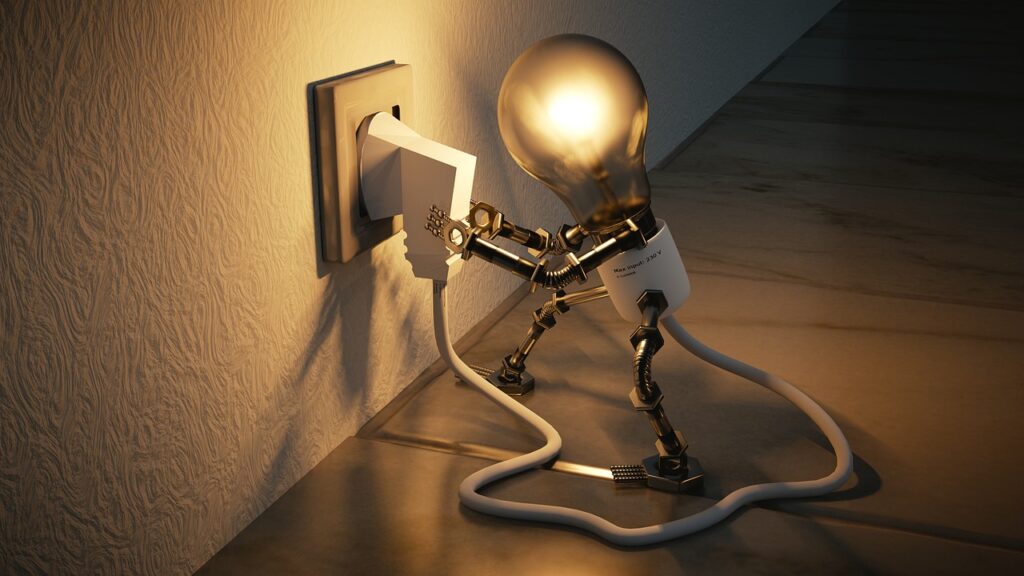
It’s been a wild few years. (Or, maybe you’d call it something other than “wild.”)
I don’t know exactly what you’ve been through or where you are now, but if you find yourself at a bit of a crossroads–a long way from where you used to be, yet still a long way from where you want to be–then you’re in the right place.
As I noted previously, there’s a name for this funky space. It’s called the Liminal Space, or the in-between.
The Liminal Space can be disorienting. It can be discouraging. It can be depressing, even.
Sometimes, you wonder if you’ll ever find your way out of it. You’re trying desperately to see a light at the end of the tunnel, yet it all just looks so… hazy.
I promise you there is a way out of it, and more than that, there’s a way to come back better than EVER.
As bold as that may sound, it’s true. It’s not hyperbole. And today, we’re going to begin that journey.
Today, I’m going to give you the same roadmap I’ve been giving to leaders and their teams all year long as a resilience keynote speaker, inspiring and equipping them to make the shift from just surviving it all–because clearly you can do that–to truly thriving, coming back better than EVER.
I call it the Reboot Roadmap–a roadmap to “begin again”–and audience members have called it “life-changing.” I hope it will be that for you, and I know it can be—because remember, one idea can change everything.
Like any journey, you need to know your destination before you get started. So, we’re going to start at the end of the roadmap and work our way back to step #1. Then we’ll spend some time on that one, and you’ll discover that you don’t have to wait until tomorrow or the next day or someday off in the future to experience the peace, joy, happiness, love, or whatever it is that you desire the most. While your circumstances may not change overnight, the quality of your life can.
Before we wrap up, I’m going to walk you through a simple exercise that takes just 2-3 minutes and will bring an immediate improvement in your life and work. It will give you another tool to add to your toolbox on this journey to coming back better than EVER.
Cool? Let’s dive in.
Four steps to come back better than EVER
For starters, let’s establish that better than EVER assumes you want something about your life and/or work to be different from what you’re experiencing right now. Like we said earlier, you’re not where you want to be.
Now, exactly what you want to change in your life or work, we’ll talk about that in a future installment, but for now, let’s just put this change you desire under the broad umbrella of “results.” That’s the fourth and final step of the Reboot Roadmap—you Change Your Results.
Knowing that’s our finish line, now we can work backward from there.
How do you change your Results?
Naturally, if you want to experience something different, you’re going to need to do something different.
You’ve likely heard the definition of insanity that’s been attributed to Einstein: “Insanity is doing the same thing over and over and expecting different results.”
Yet we often do this, don’t we? We follow the same habits, patterns, and routines that we’ve become comfortable with and then we wonder why nothing seems to change. Why does this keep happening to me? you might ask. (I know I have.)
So if you want to change your Results, then you need to Change Your Expression. This is step #3 on the Reboot Roadmap.
If that terminology sounds a bit odd to you, what we’re talking about here is changing the way you show up in the world—for yourself, for your loved ones, for your work. We’re talking about the choices you make and the actions you take. This forms your Expression.
Some programs start here and are purely behavior-oriented. You know you need to do some things differently, after all, and you’re not currently doing them, so, I need someone to teach me how to build some new habits.
I’m betting you’ve tried to implement some new habits somewhere along the way—New Year’s Resolutions, anyone? It’s about to be that time of year again.
And how does that work out?
Different studies have shown that about 80% of New Year’s Resolutions fail.
Why is this? There are a variety of reasons, of course, but a big one is that we try to change our behavior without being absolutely clear on what we want and why we want it. That’s why the Reboot Roadmap doesn’t start with behavior change.
Before we can start showing up differently on a consistent basis, we need a clear and compelling vision that pulls us forward—that’s step #2 on the Reboot Roadmap: Change Your Vision.
A lot of programs start here, for good reason. Vision is critical to thriving in times of transition. But there’s a problem.
If you’re in survival mode—as we’ve established that many people are—then it’s hard—if not impossible—to create a compelling vision for the future.
You’ve either got tunnel vision as you’re consumed with today’s problems—putting out those fires day after day after day—or you’re stuck looking back into the past, aka “the good old days.” If only we could get back there again.
If we try to create a vision while we’re in survival mode, we’re very likely going to come up with a vision of just “getting by,” or just fixing all of the current problems.
That’s not a bad thing, but it’s not a vision that gets you excited and gives you the motivation and resilience you need to consistently change your Expression and then ultimately change your Results.
So, before we change our Vision, here’s where we must begin, at step #1…
You must Change Your Energy.
I’m not talking about downing another cup of coffee or your favorite energy drink—although that’s what a lot of us rely on every day. No wonder global energy drink sales are estimated to reach $53.1 billion by the end of 2022, according to Investopedia.
I’m talking about changing your overall energetic vibration.

Four domains of energy
What creates your overall energetic vibration?
There are four domains of your energy:
- Physical
- Emotional
- Mental
- Spiritual
If I were to ask you to rate each of those domains on a scale of 1-10, with 10 being absolutely on fire, how are you doing?
Many of us aren’t doing so well.
Physically, we’re exhausted (hence the growing energy drink market).
Emotionally, people worldwide felt more worried, stressed and sad in 2021 than at any time in the past 16 years, according to Gallup’s annual Global Emotions Report .
Mentally, it’s been said that we live in a state of continuous partial attention, with little notification dings and endless demands for our attention at every turn.
Spiritually—speaking of feeling connected to something bigger than ourselves—we feel more isolated and struggle to find a sense of purpose beyond just putting out fires every day. No wonder there’s been a “Great Resignation,” or what I believe should be called a “Great Re-evaluation,” as many have sensed that life and work were out of alignment with their values.
If I were coaching you or your team, we’d look into all four domains to see what’s going on and where improvements can be made. For today, though, I want to focus specifically on your emotional energy.
Your energy is your experience
We’re going to focus on emotions because they really drive so much. And, really, emotions are our life experience.
You’re not experiencing your circumstances from one moment to the next. You’re experiencing your feelings about the circumstances.
The good news is, while circumstances may take time to change, your emotions can be changed much more quickly. Almost instantly.
This was a transformational lesson when I began the 10-year journey of turning my own life around several years ago.
On August 30, 2008, I wrote in my journal that “I feel empty. Depressed. Disappointed. Lost.”
These were also some of the words that showed up on a New York Times survey several months ago, by the way, when they asked over 1,300 therapists what they were hearing from their clients.
Along with empty, depressed, disappointed, and lost were words like overwhelmed, burned out, anxious, stuck, isolated.
And one of my favorite responses that showed up repeatedly in the survey: Done.
I know you’ve felt some of these feelings, too, whether in the past or in the present.
It’s a funny thing about this human experience—while the details of our stories vary, our experiences aren’t so different.
There were a lot of circumstances contributing to the way I was feeling in 2008—an unhealthy marriage, unfulfilling work (even though it was my business), and the Great Recession.
As much as I wanted to—and as much as I had tried in vain—those circumstances couldn’t be turned around overnight. What I learned, though, is that your energy—including your emotional experience—can be transformed much more quickly.
Dr. Jill Bolte Taylor, Harvard-trained brain scientist and author of My Stroke of Insight, found that, “When a person has a reaction to something in their environment, there’s a 90-second chemical process that happens in the body; after that, any remaining emotional response is just the person choosing to stay in that emotional loop.”
It reminds me of something I heard somewhere along the way: “There’s no such thing as a bad day, but only a bad moment that lingers.”
Let’s face it, many of us do choose to stay in that emotional loop for a while. But, if you can learn to make the shift, then you can find the peace, joy, excitement, and whatever you want to feel here and now, which also puts you in a position to move forward, so you can catch a vision of thriving, not just surviving.
Shortly, I’m going to give you that one simple exercise I mentioned which you can use to exit a disempowering emotional loop (when desired), and in doing so, you’ll boost all four domains of your energy. You may not be able to do it in 90 seconds, but you can do it within 2-3 minutes.
First, let’s look at the impact of your emotions beyond your immediate experience, and let’s talk specifically about the workplace for a moment, since that’s where most of us spend so much of our time (even if we’re working from home).

Your feelings matter… even (and especially) at work
Early on in my own “reboot” journey, I came across Shawn Achor’s bestselling book, The Happiness Advantage, as well as his popular TED Talk on “The Happy Secret to Better Work.” In that talk, Shawn shares, based on extensive research, that:
“If you can raise somebody’s level of positivity in the present, then… your intelligence rises, your creativity rises, your energy levels rise. In fact, we’ve found that every single business outcome improves. Your brain at positive is 31% more productive than your brain at negative, neutral or stressed. You’re 37% better at sales. Doctors are 19 percent faster, more accurate at coming up with the correct diagnosis when positive instead of negative, neutral or stressed.”
More recently, I read in Brené Brown’s book, Dare to Lead, that “Leaders must either invest a reasonable amount of time attending to fears and feelings, or squander an unreasonable amount of time trying to manage ineffective and unproductive behavior.”
Do you see, again, why we don’t start with changing behavior on our journey to come back better than ever?
In some ways, this may register as common sense, but let’s peek in on what we’ve gleaned from some of the scientific developments over the past 30 years that help us understand why this is…
It’s more than a feeling
First, it’s important to note what’s happening in the brain when we go into survival mode, or when the stress response is activated.
In those moments, your brain function shifts heavily to the more instinctive areas of the brain. Your amygdala senses a threat and sends out the alarm—“danger!”—and the appropriate bodily functions are triggered.
For example, blood flow increases to your limbs to strengthen muscles to run or fight. Cortisol and other chemicals are released to turn off the body’s long-term functions—like digestion and metabolism—so as many resources as possible can be devoted to survival.
Our survival instinct is really quite amazing… when it’s triggered in the appropriate environment, like when there is an immediate threat.
These days however, especially for the audiences and clients I work with, the threats we face are more psychological than physical. You’re not likely to face the threat of a bear attack on a daily basis, but that stack of papers on your desk or that overflowing inbox is coming for you—or so we think.
Staying in such an escalated state—with your body being flooded by stress hormones—is not a healthy place to live. As a matter of fact, studies have shown that dwelling in survival emotions such as fear, frustration, and anger over time leads to:
- Reduced muscle mass
- Brain-cell death
- Impaired memory
- Accelerated aging
- Impaired mental function
- Diminished performance
These are not the “better than EVER” results any of us are aiming for, and this is not the emotional energy that will allow us to find a way forward.
What if we could rise and thrive?
As you can imagine, what we need to navigate through uncertain, disruptive times, are qualities like focus and the ability to learn some new things, to reason, problem-solve, plan, and make decisions. We’re going to need some creativity. We’re going to need some courage to adopt new behaviors.
You have all of these capabilities within you, right now. You can’t fully tap into any of these capabilities in an energy of survival, though.
In survival mode, you’re less confident, you experience more doubt and fear, you’re unmotivated (“why bother?”), you’re scattered and struggle to stay on task, you have little desire to take on new challenges, and you’re more on edge and easily triggered (because you have fewer resources for emotional regulation).
One reason for this is because as the amygdala region of the brain is “turned on,” as noted previously, the upper regions of the brain—such as the prefrontal cortex (PFC)—which are needed for higher cognitive functions, are “turned off.” (This shows up on brain scans in the form of increased blood flow to some areas and decreased blood flow to others.)
If we shift out of survival mode and turn the prefrontal cortex back on again, that’s where we are able to tap into thoughts of who we are and what we value. It’s where you find reasoning and problem solving. It’s where you’re able to plan for the future.
As you’ll soon see, making this shift is as simple as shifting your attention (what you’re focused on), your attitude (what you’re thinking), and your action (what you’re doing). These are your three tools of creation to rise above your circumstances.
And in contrast to the consequences of dwelling in survival emotions, spending more time in elevated emotions such as love, appreciation, care, and gratitude causes the release of neurochemicals that are regenerative in nature and offset energy drain, with additional benefits such as:
- Increased longevity
- Increased resilience to adversity
- Increased memory
- Increased problem-solving
- Increased intuition and creativity
- Increased job performance and achievement
Wouldn’t you agree that these results are aligned with coming back better than EVER?
And going back to the workplace again, aren’t these also the qualities of a great leader?
And if you are a leader, aren’t these the qualities you want in your team members?
In this energetic state, you find all the qualities you need to Change Your Vision—being open to new ideas, for example—and Change Your Expression—finding more courage and confidence to step outside of your comfort zone—so you will Change Your Results as desired.
So, let’s talk about how to do that.

You know how to do this
There are an abundance of ways to change your energy—especially when you consider the four domains of your energy.
If you want to change your physical energy, for example, sleep, hydration, nutrition, and exercise will do it. Do those things well and you’ll have more energy; do them poorly and you’ll have less. Personally, I also love to throw in a one-person dance party or some gentle Qigong, also known as “meditation with movement” depending on whether I need to crank up or calm down.
If you want to change your mental, emotional, or spiritual energy, you might look to activities like therapy, coaching, journaling, educational classes, prayer, or meditation. Walking in nature is also one of my favorites—combining the physical element while also helping me reconnect with the natural rhythms of life to ease my mind, heart, and spirit.
No doubt, you have some favorite ways to change your energy, which you might want to pause and write down, right now.
- What is something that lifts you up?
- What is something that calms you down?
- What is something that makes you feel fully centered and grounded?
And then most importantly: When is the last time you did one of those activities?!
If it’s been a while, I encourage you to get out your calendar right now and make an appointment for yourself this week—even if it’s for just 15 minutes—to do something that changes your energy in a way that feels good.
But what if you could feel good right now?
Since I first woke up to the idea that “this moment matters” back in 2011, I’ve been on the lookout for tools and strategies that can change your life in a moment. We all know about the importance of lifestyle changes—all those things we should do. But, what can I do right now?
If the only moment we can truly experience is this one, I don’t want to postpone my happiness, peace, joy, love, gratitude, or any other “good” feeling for “someday” off in the future… once we get on the other side of this Liminal Space.
Thankfully, you don’t have to.
In a moment, I’m going to share a tool I learned and began using with my clients back in 2020, when, seeking additional ways to support them in a time of crisis, I became a HeartMath Certified Practitioner for Stress, Anxiety and Self-Regulation.
If you’re not familiar with the HeartMath Institute, for more than 30 years their doctors and scientists have been researching the heart-brain connection, particularly as it relates to stress and resilience. One of the key findings is the fact that the heart sends more signals to the brain than the brain sends to the heart. And, these signals have a direct impact on brain function—”influencing emotional processing as well as higher cognitive faculties such as attention, perception, memory, and problem-solving.”
What this means is that if we can intentionally cultivate a positive emotion—as you’ll soon learn how to do—then you can bring all of your body’s key systems into coherence. Think of it like getting an orchestra to play in sync.
In a state of stress, your body is out of sync—I’m sure you know the feeling well—but in sync, or in coherence, your body—including your brain—comes into a more optimal state of functioning and you find a sense of calm, clarity, and energy to meet the challenges of the day.
That’s why, once again, not only does it feel good to feel good, but when you feel better, you do better.
The tool I’m going to share with you is called the Heart Lock-In technique, and it’s one I’ve used with great success with my coaching clients who come to me seeking relief from stress. There are only three steps:
Step 1. Shift your attention to the area of your heart and breathe slowly and deeply.
Step 2. Activate and sustain a genuine feeling of appreciation or care for someone or something in your life.
Step 3. Radiate these feelings of care toward yourself and others.
That’s it.
This single exercise will allow you to boost the energy across all four domains of your energy:
- Breathing in a slower and deeper manner supports your physical energy.
- Focusing on your heart supports your mental energy.
- Cultivating a feeling of appreciation or care supports your emotional energy.
- And sending feelings of care toward others supports your spiritual energy.
In the process, you will renew and recharge your emotional system so you can better face the stressors that abound today.
You don’t have to take my word for it, though. Try it and see for yourself.
Click play below I’ll guide you through it:
It’s okay if you catch your mind wandering during the exercise, by the way. That’s just your mind doing what it does. There’s nothing wrong with it! In those cases, simply refocus your attention on the heart area and reconnect with feelings of care or appreciation.
After we’re finished, sustain your feelings of care and appreciation as long as you can as you transition into the rest of your day.
And if you like what you experience and want to really maximize the benefit, do the exercise 2-3 times a day for the rest of this week. If you want to take it even further, keep that up for the next 6-8 weeks. This is where you really begin to experience some of the benefits we talked about earlier, and you establish a new baseline for yourself to meet the world around you.
You’re on the road to coming back better than EVER
I applaud you for taking this first step on the road to come back better than EVER. And I thank you for letting me walk with you.
I hope to see you back here next week for Step Two on the Reboot Roadmap. Make sure you sign up for email updates—and get a free digital copy of my book, Unstoppable—so you don’t miss it!
